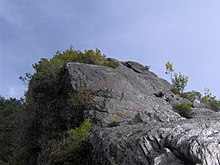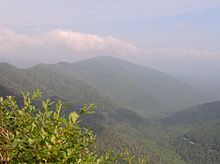Chimney Tops
Chimney Tops is a mountain in the central Great Smoky Mountains. It is 4,724 feet (1,440 m) above sea level.[3] Chimney Tops is a double-capstone knob on the eastern slope of the Sugarland Mountain massif, which stretches north-south across the north-central section of the Smokies. Mount Le Conte resides east of Chimney Tops, and Mt. Mingus southeast of Chimney Tops. Thus, while the view from the summit is 360 degrees, Chimney Tops is practically "walled in" on three sides.
| Chimney Tops | |
|---|---|
 Chimney Tops, looking south from Newfound Gap Road (US Route 441). | |
| Highest point | |
| Elevation | 4724 feet (1440 m) NAVD 88 |
| Prominence | 120 ft (37 m) [1] |
| Coordinates | region:US-TN scale:100000 source:NPS 35°37′50″N 83°28′42″W [2] |
| Geography | |
| Location | Sevier County, Tennessee |
| Parent range | Great Smoky Mountains |
| Topo map | NPS "Mount Le Conte" (PDF). |
| Climbing | |
| Easiest route | Chimney Tops Trail, short climb |
Geology
Chimney Tops is one of the few instances of a bare rock summit in the Smokies.[4] The bedrock atop the mountain has been exposed to natural weathering of the upper layers of soil strata. The bedrock is mostly Anakeesta Formation metamorphic rock, especially slate, phyllite, and metasiltsone.[5] It was formed 200 million years ago when the North American and African plates collided during the Appalachian orogeny.[6]
History

The Cherokee name for Chimney Tops is Duniskwalgunyi, or "forked antler", referring to its resemblance to the deer antlers.[7] In the Cherokee legend "Aganunitsi and the Uktena", the captured medicine man, Aganunitsi, to free himself, searches remote parts of the Smokies to find the giant reptile, the Uktena, and seize an amulet from its forehead. In his quest, Aganunitsi searches distant gaps and peaks in the Smokies before going to Duniskwalgunyi, the Gap of the Forked Antler, and to the lake of Atagahi, and at each found monstrous reptiles."[8]

The Road Prong Trail, which follows the stream of the same name at the base of Chimney Tops, is one of the oldest trails in the Smokies. In the 18th and 19th centuries, this ancient path was known commonly as the Indian Gap Trail. In 1832, the Oconaluftee Turnpike was constructed between Indian Gap and Smokemont. This road was expanded during the Civil War by Cherokee leader Col. Will Thomas, running parallel to the modern trail.[9]
The mountain's current name was probably given to it by residents of the Sugarlands, a valley to the north of the mountain that was home to a small Appalachian community before the national park was formed. Before the Sugarlands was reforested, Chimney Tops was clearly visible from most of the valley. Local legend even suggested that the top of the mountain was covered in soot.[10]
Access

A common route to closely see the peaks is the Chimney Tops Trail, which can be accessed about 6.9 miles south/east of the Sugarlands Visitor Center on Newfound Gap Road. Before the summit part of the trail was closed, the trail ended at the foot of the south capstone (the higher of the two), but various unmaintained spurs crossed over to the lower summit.
Another route is to follow the Appalachian Trail west from Newfound Gap to the Road Prong Trail. The Road Prong Trail, following the river at the base of the mountain, connects the Appalachian Trail with the Chimney Tops Trail. This route is twice as long as the route from the Chimney Tops parking lot.
While no technical gear was needed, a climb was necessary to reach the capstones. From the summit, Mount Le Conte and Mount Kephart can be seen in the east, the Sugarland Mountain in the west and the Sugarlands valley in the north.
A severe fire in late 2016 led to closure of many trails in the Great Smoky Mountains, including in the Chimney Tops area. The trail reopened in October 2017, with a new observation area that offers a place to view both of the bare rock points of the summit. However, due to the extreme heat of the fires, access to the summit is no longer permitted.[11]
References
- "Chimney Tops, Tennessee". Peakbagger.com.
- "Chimney Tops". Geographic Names Information System. United States Geological Survey.
- "Mt Le Conte Quadrangle, Great Smoky Mountains 7.5 minute 1:24,000-scale series Topographic Maps" (PDF). National Park Service. Retrieved 2013-12-08.
- Brewer, Carson (1993). Great Smoky Mountains National Park. Portland, Ore: Graphic Arts Center Publishing. p. 101. ISBN 1-55868-126-4.
- Moore, Harry (1988). A Roadside Guide to the Geology of the Great Smoky Mountains National Park. Knoxville: University of Tennessee Press. pp. 7, 107. ISBN 0-87049-558-5.
- Moore, Harry (1988). pp. 26–27.
- Mooney, James (1972). Myths of the Cherokee and Sacred Formulas of the Cherokee. Nashville: Charles Elder. p. 516..
- Mooney, James (1972) p. 299.
- Strutin, Michael (2003). History Hikes of the Smokies. Gatlinburg: Great Smoky Mountains Association. pp. 322–324. ISBN 0-937207-40-3.
- Frome, Michael (1994). Strangers In High Places: The Story of the Great Smoky Mountains. Knoxville: University of Tennessee Press. p. introduction.
- Temporary Road and Facilities Closures, National Park Service website. Accessed: 16 March 2017.
External links
- "Great Smoky Mountains National Park: Maps".
- "Chimney Tops". SummitPost.org. Retrieved 2011-05-09.
- "Mount Le Conte Geological Study". Appalachian Blue Ridge Project. United States Geological Survey. Archived from the original on 2011-12-27. Retrieved 2011-05-09. Contains an excellent section on the geology of Chimney Tops.
| Wikimedia Commons has media related to Chimney Tops. |